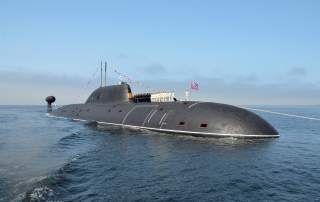How the U.S. Navy Is 'Helping' Russia's Submarines Become Even More Deadly
If the Russians realize their vision for the Husky, the new boat should provide Moscow with a design the Kremlin can build in large quantities.
The Russians expect to start off with a basic SSN design that would displace between 8,000 and 9,000 tons and have speed of between 32 to 33 knots. The vessel would be armed with torpedoes and sea-mines, but could launch cruise missiles via its torpedo tubes. The Russians also want the vessel to be able to deliver and recover special operations forces and their gear—just like the Virginia-class.
The Russian Navy is taking a page out of the United States Navy’s playbook as it develops its family of next generation nuclear submarines.
Tentatively called Project Husky, the new submarines will be built in three variants—a basic attack submarine model, an expanded guided-missile submarine (SSGN) version and an enlarged ballistic missile submarine (SSBN) variant writes Ilya Kramnik, a defense reporter with Lenta.ru. The new vessels are expected to start construction in the 2020-2021 timeframe.
Recommended: Could the Battleship Make a Comeback?
The Russians are trying to ensure that all three versions of the Husky retain the maximum amount of commonality. In many respects, the new submarines are similar in concept to the U.S. Navy’s Virginia-class SSNs that were developed after the end of the Cold War when the extremely potent Seawolf-class boats proved to be far too expensive.
Recommended: 5 Worst Generals in U.S. History
(This first appeared in July.)
The Virginia-class started off as a basic SSN design, but has evolved into an SSGN with the addition of the Virginia Payload Module (VPM) in future boats of the class. Moreover, in many ways, the U.S. Navy’s forthcoming Columbia-class SSBNs are also a direct evolution of the Virginia-class design—leveraging most of the older SSN design’s technology and systems onboard a larger hull.
Recommended: 5 Reasons No Nation Wants to Go to War with Israel
The Husky will follow a similar path as the Virginia-class design, Kramnik notes.
The Russians expect to start off with a basic SSN design that would displace between 8,000 and 9,000 tons and have speed of between 32 to 33 knots. The vessel would be armed with torpedoes and sea-mines, but could launch cruise missiles via its torpedo tubes. The Russians also want the vessel to be able to deliver and recover special operations forces and their gear—just like the Virginia-class.
The SSGN version and the SSBN variant would be built by stretching the submarine by adding an extra hull section—similar to how the VPM adds four payload tubes each capable of launching seven cruise missiles from a Multiple all-up-round Canister (MAC) by means of a hull plug. The Russians, too, are looking at developing a MAC canister that would rapidly enable the SSBN version to switch their payloads over to carrying cruise missiles in packs of five to seven weapons per tube. That’s similar in concept to America’s four Ohio-class SSGNs that were originally armed with Trident II submarine launched ballistic missiles.
Presumably, the Husky SSBN variant would be scaled-up from the SSN and SSGN versions in a manner similar to how the Columbia-class is essentially a larger derivative of the Virginia in terms of its sensors and most of its machinery. Indeed, Kramnik states that all of the Husky-class variants would have the same sensors and propulsion systems—including the same life-of-the boat pressurized water reactor—all of which are advanced derivatives of systems onboard the Project 995A Borei-class SSBN and Project 885M Yasen-class SSGNs.
The Russians hope that the Husky will be significantly more affordable than the Project 885M SSGNs, which are excellent submarines, but are extremely expensive. Indeed, given the economies of scale in terms of common parts and systems, the Russians hope to bring the cost of the Husky down to a level where they can build a minimum of 16 to 20 of the attack and SSGN versions of the boat—and possibly more. The Russians would ideally like to be able to order one new boat every two years with deliveries taking no more than four and a half years from the start of construction. If all goes as planned, the first Husky would be delivered in 2025 while the last would be delivered in the 2030s.
The SSBN version would be built after the last of the Project 995A Borei-class ballistic missile submarines are delivered. According to Kramnik, the next generation boomer would help Russia to continue upgrading its nuclear forces in the 2020s if Moscow can’t reach further nuclear arms control agreements with the United States.
However, U.S. analysts such as Center for Naval Analyses researcher Michael Kofman are somewhat puzzled by the Russians’ desire to build another SSBN class.
“It's unclear why they need a new SSBN,” Kofman told The National Interest.
“I think an SSN is really a stronger priority.”
If the Russians realize their vision for the Husky, the new boat should provide Moscow with a design the Kremlin can build in large quantities and replace the Soviet-era vessels that still comprise the bulk of their fleet. But even with the addition of the advanced Husky-class, the Russian undersea force—though armed with potent new vessels—will not be the menace that the massive Soviet fleet once was.
Dave Majumdar is the defense editor for The National Interest. You can follow him on Twitter: @Davemajumdar.
Image: Reuters.

